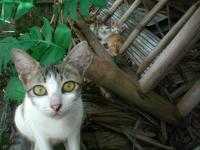What You Need To Make Natural Homemade Pet Food
Sponsored Links
Balanced raw foods make the most sense from a natural and scientific point of view.
— Dr. Michael Lemon, DVM
The following pages are written in note form when possible and are to the point.
The following pages tell you exactly what you need to make homemade pet food and nothing else.
Muscle Meats
We use the meats that are most commonly found. We do not use meats that can cause trichinosis like pork. The following meats are most commonly fed:
chicken, lamb, beef, turkey, eggs, goat
- When feeding muscle meats only feed one at a time. In other words try not to combine meats when possible.
- You can feed ground meat or meat chunks.
- Ground meat is easier for mixing vegetables and supplements in, adding more moisture to the meat and ground meat is, generally speaking, easier to make warm. But meat chunks can be fed.
- Some will say that meat chunks are actually better since no small pieces of meat get stuck between the teeth. This can be important for preventing dental problems. Others also say that meat chunks are a more natural form of food eaten by our carnivore friends.
- Taking the above into account, I personally prefer to feed meat chunks to cats because vegetables are not as important to cats as they are to dogs. Some cats won't eat their meat if vegetables are mixed in. Other cats love their vegetables. So if the cat doesn't like vegetables at all, then meat chunks should only be fed. If the cat enjoys or tolerates vegetables, then ground meat is an option for cats.
- Over the years, I have noticed that cats eating ground meat tend to eat more slowly as they have to pick small morsels of ground meat with their incisors, which is not how a cat normally eats. As a result, cats eating ground meat tend to eat smaller meals and tend to eat their meals more slowly. However, I have found that cats eating chunks of meat tend to eat their food faster. Feeding meat chunks to cats allows them to eat more naturally. The cat will grab the meat chunk and then break the meat chunk down to the size they need with their molars before swallowing. This ultimately allows the cat to eat a larger meal faster. This in turn helps to ensure the cat is more satisfied which helps to eliminate the habit of free feeding.
- For dogs, they usually inhale the meat and so when you do feed ground meats, they often don't even chew it. They just lick it up and swallow. Instantly gone.
- Realizing that dogs usually lick the ground meat and then swallow, the chances of having ground meat stuck in the teeth is low. Since some vegetables are important to dogs, I feed dogs ground meat more often but feeding dogs meat chunks is also good.
- In some situations you can feed meat chunks to a dog with the ground vegetables to the side. The dog will eat both the meat and vegetables. If your dog will eat the vegetables in this way, then I would choose this option because ultimately, meat chunks are better than ground meat.
- When feeding meat chunks to our pets, it is harder to make the meat chunks warm. You can feed the meat right away if the meat is not too cold coming from the fridge. Otherwise, let it sit on the counter top for an hour so more of the meat is at room temperature. You see, the problem with meat chunks is that it is easy to warm the exterior of the meat but not the interior. However, we are not seeking perfection here. Instead, we are seeking the best solution based on the situation and circumstances. So even if you feed meat chunks and it is a little bit cold, it's not the end of the world. Saying that, some pets will only eat their food if it is tepid to warm.
- Adding supplements to meat chunks can be slightly more difficult. With ground meat, the powdered supplements are easily mixed in. But with meat chunks, not so. Hence, I simply rub or apply any of the supplements to the ground meat and sort of rub them in a little with a spoon or fork (just so the powdered supplements stick to the meat because otherwise, the powdered supplements can just fall off). I don't spend much time doing this, in fact, probably just a few seconds. But it's enough time so the dog or cat cannot easily shake the supplements off the meat!
- One last thought on meat chunks — and this is for those with cats. Some cats will be more likely to play with the meat chunk before, during or after eating. This can be either entertaining or frustrating as you see a meat chunk flying across the room. I'm not saying it's going to happen, but it's just a little warning in advance in case it does happen!
- Feed meats with normal fat content as dogs and cats require the raw fat for healthy skin.
- Do not feed fat by itself as this could potentially lead to pancreatitis.
- Do not feed fat that has been cooked as a dog or cat cannot digest cooked fat. Cooked fat is grease, raw fat is just fat.
- Cooked fat can also potentially lead to problems such as pancreatitis. Many pets have been known to get pancreatitis after their owners have fed them the cooked skin of the chicken they were eating. Of course, the owner thought they were giving the dog or cat a nice treat or snack, but it can cause serious health problems. Often, pancreatitis doesn't happen over night. Instead, this sort of problem just begins to happen slowly but when it does happen, you will wish it never did.
- Although some specialty meats are more expensive, I occasionally feed them to add variety.
- Examples of specialty meats are: moose, musk ox, bison, ostrich, emu, and venison.
- The good news about specialty meat is that the meat is usually very pure.
- If you are feeding poultry, such as boneless chicken thighs, use the raw skin as the source of fat. Since we feed a normal amount of fat, use a normal amount of skin. As an example, if you feed chicken meat that is 1 inch (2.5 cm) square, then use enough skin to cover the surface of the meat.
- When feeding poultry, feed dark meat rather than white meat if you can. Dark meats have more nutrition than white meat.
- You can, if you want, soak any utensils that have come in contact with meat, especially poultry in a solution of hot water and grapefruit seed extract.
- Grapefruit seed extract will be available at any health food store so just ask a clerk. They usually have pamphlets which give you an idea of how many drops of extract to use.
- A small bottle of extract can last one, maybe two years and has many uses.
- Ultimately though, when using utensils with raw meat, you do the same things as if you were preparing a meat dish for your family or yourself. Many people get paranoid about the utensils touching poultry yet fail to remember that they prepare chicken or turkey all the time for themselves. You do not need to get paranoid about salmonella, etc, but the reality is you just need to apply common sense rules to cleaning any utensil that has touched raw meat.
A Special Note About Eggs
Today, there are more people selling free range eggs! Don't be afraid to feed eggs to your pets.
Eggs are quick and simple to prepare and in addition, eggs are relatively cheap. Free range eggs are usually quite healthy as the quality of free range eggs (depending upon the person who feeds and takes care of the free range chickens) is higher.
Straight To The Point
This section is all about getting to the point. There aren't many pages to read in this section, so just keep reading:
- Meats That You Can Feed
- What Meats Should Not Be Fed
- Organ Meats
- Vegetables You Can Feed
- Vegetables You Should Not Feed
- Utensils Needed
 Meet Jumbo, the participant in
Meet Jumbo, the participant in 